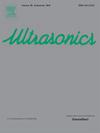An online data-driven method for predicting crack propagation and remaining fatigue life via combining linear and nonlinear ultrasonic
IF 3.8
2区 物理与天体物理
Q1 ACOUSTICS
引用次数: 0
Abstract
Ultrasonic features play a critical role in evaluating the structural integrity of metallic components, yet current approaches predominantly rely on individual ultrasonic parameters for predictive analysis. This study presents an online data-driven method that combines linear and nonlinear ultrasonic parameters through an optimized weighting function to predict crack propagation and remaining fatigue life (RFL) over the entire fatigue life from microstructural changes to macroscopic crack formation of plate structures. LSTM neural networks are employed to learn sequential features captured by various PZTs. Experimental results on 6061 aluminum plates demonstrate that the proposed method predicts crack length and RFL with average errors of 0.568 mm and 4.50 % of the total fatigue life of the structure, respectively. Comparative analysis reveals that the combined approach with the optimal weighting function outperforms predictions using individual parameters. This method shows significant robustness under varying conditions, underscoring its potential for real-time fatigue monitoring and predictive maintenance.
基于线性和非线性超声的裂纹扩展和剩余疲劳寿命在线预测方法
超声特征在评估金属构件的结构完整性方面起着至关重要的作用,但目前的方法主要依赖于单个超声参数进行预测分析。本文提出了一种在线数据驱动方法,通过优化加权函数,将线性和非线性超声参数相结合,预测板结构从微观组织变化到宏观裂纹形成的整个疲劳寿命中的裂纹扩展和剩余疲劳寿命(RFL)。采用LSTM神经网络学习各种pzt捕获的序列特征。对6061铝板的试验结果表明,该方法预测裂纹长度和RFL的平均误差分别为0.568 mm和4.50%。对比分析表明,结合最优加权函数的组合方法优于使用单个参数的预测。该方法在不同条件下显示出显著的鲁棒性,强调了其在实时疲劳监测和预测性维护方面的潜力。
本文章由计算机程序翻译,如有差异,请以英文原文为准。
求助全文
约1分钟内获得全文
求助全文
来源期刊

Ultrasonics
医学-核医学
CiteScore
7.60
自引率
19.00%
发文量
186
审稿时长
3.9 months
期刊介绍:
Ultrasonics is the only internationally established journal which covers the entire field of ultrasound research and technology and all its many applications. Ultrasonics contains a variety of sections to keep readers fully informed and up-to-date on the whole spectrum of research and development throughout the world. Ultrasonics publishes papers of exceptional quality and of relevance to both academia and industry. Manuscripts in which ultrasonics is a central issue and not simply an incidental tool or minor issue, are welcomed.
As well as top quality original research papers and review articles by world renowned experts, Ultrasonics also regularly features short communications, a calendar of forthcoming events and special issues dedicated to topical subjects.
 求助内容:
求助内容: 应助结果提醒方式:
应助结果提醒方式:


